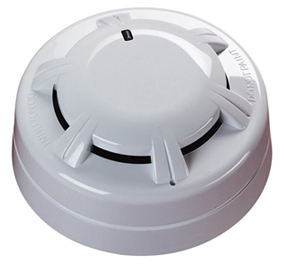Optical Smoke Detector ORBIS

A new sensor design enables the Orbis optical smoke detector to respond to a wide spectrum of fires without compromising reliability.
The detector is calibrated to make it highly reliable but much less likely to generate false alarms. It uses algorithms to decide when is should change to the alarm state. Orbis optical detectors sample the atmosphere every four seconds and the measurements are processed by microprocessor.
The processing power is used as part of the design to eliminate unwanted alarms.
How does the orbis IS optical detector work?
The Orbis Optical IS smoke detector operates on the well established light scatter principle. The remarkable optical design of the Orbis IS optical smoke detector allows it to respond to a wide spectrum of fires.
The sensing chamber of the Orbis IS optical smoke detector contains an optical sensor which measures back-scattered light as well as the more usual forwardscattered light. Sensitivity to black smoke is greatly improved.
The detector is calibrated so that it is highly reliable in detecting fires but is much less likely to generate false alarms than ionisation smoke detectors.
The stability of the detector–high reliability, low false alarm rate–is further increased by the use of algorithms to decide when the detector should change to the alarm state. This removes the likelihood of a detector producing an alarm as a result of smoke from smoking materials or from another non-fire source.
The sensing chamber has been designed to keep out dust and other airborne contaminants.
Environmental performance
The operating temperature for instrinsically safe detectors is restricted by the gas temperature class.
Classification
| II 1G Ex ia IIC | –40°C<Ta<+40°C(T5) |
|
|
–40°C<Ta<+60°C(T4) |
BASEEFA Certificate number
ATEX—Baseefa 06 ATEX 0007X
IECEx—IECEx BAS 06.0002X
Technical data
All data is supplied subject to change without notice. Specifications are given at 23°C and 50% relative humidity unless otherwise stated.
Detector Operating Principles
Principle of detection: Photo-electric detection of light scattered by smoke particles over a wide range of angles. The optical arrangement comprises an infra-red emitter with a prism and a photo-diode at 90° to the light beam with a wide field of view. The detector’s microprocessor uses algorithms to process the sensor readings.
Sampling frequency: Once every 4 seconds
Electrical
Supply voltage: 14—28V DC
Supply wiring: 2 wires, polarity sensitive
Polarity reversal: Not allowed
Power-up time: <20 seconds
Minimum ‘detector active’ voltage: 12V
Switch-on surge current at 24V: 105µA
Average quiescent current at 24V: 85µA
Alarm load: 325Ω in series with a 1.0V drop
Minimum holding voltage: 5V
Minimum voltage to light alarm LED: 6V
Alarm reset voltage: <1V
Alarm reset time: 1 second
Remote output LED (–) characteristic: 4.7kΩ connected to negative supply
Mechanical
Material: Detector and base moulded in white polycarbonate.
Alarm Indicator: Integral indicator with 360° visibility
Dimensions and weight of detector: 100mm diameter x 42mm / Weight, 75g
Dimensions and weight of detector in base: 100mm diameter x 50mm / Weight, 135g
Enviromental
Operating and storage temperature –40°C to +70°C
Operating temperature is restricted by the intrinsic safety gas classification.
Class T5: –40°C to +40°C
Class T4: –40°C to +60°C
The detctor must be protected from conditions of condensation or icing.
Humidity: 0% to 98% relative humidity (no condensation)
Wind speed: Unaffected by wind
Atmospheric pressure: Insensitive to pressure
IP rating to EN 60529: 1992*: 23D
Electromagnetic Compatibility: The detector meets the requirements of BS EN 61000-6-3 for emissions and BS EN50 130-4 for susceptibility.
*The IP rating is not a requirement of EN 54–7: 2000 since smoke detectors have to be open in order to function. An IP rating is therefore not as significant as with other electrical products